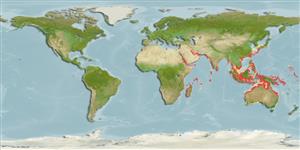Bivalvia |
Cardiida |
Cardiidae
Environment: milieu / climate zone / depth range / distribution range
Ecology
Benthic; brackish, usually 0 - 25 m (Ref. 75831). Tropical
Indo-West Pacific: Reported from East Africa, including South Africa and the Red Sea, to southern Japan, the Philippines, and eastern Indonesia.
Length at first maturity / Size / Weight / Age
Maturity: Lm ? range ? - ? cm Max length : 6.0 cm SHL male/unsexed; (Ref. 348); common length : 5.0 cm SHL male/unsexed; (Ref. 348)
The distribution of this species is imperfectly known because of frequent confusion with other species of the genus (Ref. 348). Found in intertidal areas, in mud and sand, (Ref. 75831) and shallow sublittoral waters (Ref. 348). In sheltered bays and estuaries (Ref. 348).
Life cycle and mating behavior
Maturity | Reproduction | Spawning | Eggs | Fecundity | Larvae
Members of the class Bivalvia are mostly gonochoric, some are protandric hermaphrodites. Life cycle: Embryos develop into free-swimming trocophore larvae, succeeded by the bivalve veliger, resembling a miniature clam.
Poutiers, J.M. 1998 Bivalves. Acephala, Lamellibranchia, Pelecypoda. p. 123-362. In Carpenter, K. E. and V. H. Niem. 1998. FAO species identification guide for fishery purposes. The living marine resources of the Western Central Pacific. Volume 1. Seaweeds, corals, bivalves, and gastropods. Rome, FAO. (Ref. 348)
IUCN Red List Status
(Ref. 130435: Version 2025-1)
CITES status (Ref. 108899)
Not Evaluated
Not Evaluated
Threat to humans
Harmless
Human uses
| FishSource |
Tools
More information
Trophic EcologyFood items (preys)
Diet composition
Food consumption
Predators
Population dynamicsGrowth
Max. ages / sizes
Length-weight rel.
Length-length rel.
Length-frequencies
Mass conversion
Abundance
Life cycleReproductionMaturityFecunditySpawningEggsEgg developmentLarvae PhysiologyOxygen consumption
Human RelatedStamps, coins, misc.
Internet sources
Estimates based on models
Preferred temperature
(Ref.
115969): 24.1 - 29.2, mean 28.2 (based on 1694 cells).
Fishing Vulnerability
Low vulnerability (10 of 100).
